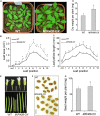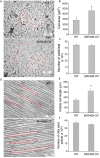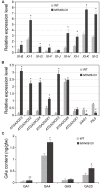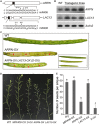Constitutive Expression of miR408 Improves Biomass and Seed Yield in Arabidopsis
- PMID: 29422907
- PMCID: PMC5789609
- DOI: 10.3389/fpls.2017.02114
Constitutive Expression of miR408 Improves Biomass and Seed Yield in Arabidopsis
Abstract
miR408 is highly conserved among different plant species and targets transcripts encoding copper-binding proteins. The function of miR408 in reproductive development remains largely unclear despite it being known to play important roles during vegetative development in Arabidopsis. Here, we show that transgenic Arabidopsis plants overexpressing MIR408 have altered morphology including significantly increased leaf area, petiole length, plant height, flower size, and silique length, resulting in enhanced biomass and seed yield. The increase in plant size was primarily due to cell expansion rather than cell proliferation, and was consistent with higher levels of myosin gene expression and gibberellic acid (GA) measured in transgenic plants. In addition, photosynthetic rate was significantly increased in the MIR408-overexpressing plants, as manifested by higher levels of chloroplastic copper content and plastocyanin (PC) expression. In contrast, overexpression of miR408-regulated targets, Plantacyanin and Laccase 13, resulted in reduced biomass production and seed yield. RNA-sequencing revealed that genes involved in primary metabolism and stress response were preferentially enriched in the genes upregulated in MIR408-overexpressing plants. These results indicate that miR408 plays an important role in regulating biomass and seed yield and that MIR408 may be a potential candidate gene involved in the domestication of agricultural crops.
Keywords: biomass; copper; miR408; photosynthesis; seed yield.
Figures






Similar articles
-
Overexpression of microRNA408 enhances photosynthesis, growth, and seed yield in diverse plants.J Integr Plant Biol. 2018 Apr;60(4):323-340. doi: 10.1111/jipb.12634. Epub 2018 Mar 14. J Integr Plant Biol. 2018. PMID: 29330900
-
miR408 is involved in abiotic stress responses in Arabidopsis.Plant J. 2015 Oct;84(1):169-87. doi: 10.1111/tpj.12999. Plant J. 2015. PMID: 26312768
-
The Evolution and Functional Roles of miR408 and Its Targets in Plants.Int J Mol Sci. 2022 Jan 4;23(1):530. doi: 10.3390/ijms23010530. Int J Mol Sci. 2022. PMID: 35008962 Free PMC article. Review.
-
miR408 overexpression causes increased drought tolerance in chickpea.Gene. 2015 Jan 25;555(2):186-93. doi: 10.1016/j.gene.2014.11.002. Epub 2014 Nov 4. Gene. 2015. PMID: 25445265
-
SQUAMOSA promoter binding protein-like7 regulated microRNA408 is required for vegetative development in Arabidopsis.Plant J. 2013 Apr;74(1):98-109. doi: 10.1111/tpj.12107. Epub 2013 Feb 28. Plant J. 2013. PMID: 23289771
Cited by
-
Conserved Cu-MicroRNAs in Arabidopsis thaliana Function in Copper Economy under Deficiency.Plants (Basel). 2019 May 29;8(6):141. doi: 10.3390/plants8060141. Plants (Basel). 2019. PMID: 31146453 Free PMC article.
-
Combined QTL-sequencing, linkage mapping, and RNA-sequencing identify candidate genes and KASP markers for low-temperature germination in Oryza sativa L. ssp. Japonica.Planta. 2023 May 18;257(6):122. doi: 10.1007/s00425-023-04155-7. Planta. 2023. PMID: 37202578
-
MicroRNA transcriptomic analysis of the sixth leaf of maize (Zea mays L.) revealed a regulatory mechanism of jointing stage heterosis.BMC Plant Biol. 2020 Nov 30;20(1):541. doi: 10.1186/s12870-020-02751-3. BMC Plant Biol. 2020. PMID: 33256592 Free PMC article.
-
Mapping and Screening of Candidate Gene Regulating the Biomass Yield of Sorghum (Sorghum bicolor L.).Int J Mol Sci. 2024 Jan 8;25(2):796. doi: 10.3390/ijms25020796. Int J Mol Sci. 2024. PMID: 38255870 Free PMC article.
-
Characterization of the microRNA408-LACCASE5 module as a regulatory axis for photosynthetic efficiency in Medicago ruthenica: implications for forage yield enhancement.Front Genet. 2023 Nov 28;14:1295222. doi: 10.3389/fgene.2023.1295222. eCollection 2023. Front Genet. 2023. PMID: 38090155 Free PMC article.
References
LinkOut - more resources
Full Text Sources
Other Literature Sources
Molecular Biology Databases

